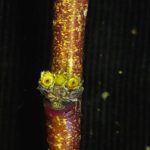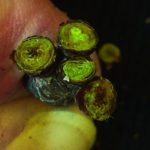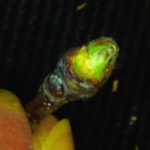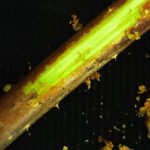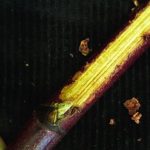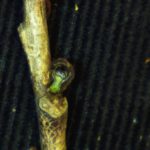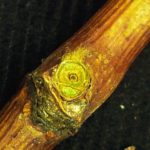This winter was significantly colder than normal in the northern half of Indiana. Many areas north of “I-70” experienced temperatures between -15 and -20˚F in early January. That is cold enough to cause considerable cold injury to grapes, peaches, and blackberries. Ten below zero is a commonly accepted threshold for seeing damage to cold sensitive crops. In Lafayette, we had a minimum winter temperature of -19˚F on Jan. 2, but also had three other mornings when temperature reached -17˚F.
We have evaluated fruit crops at the Meigs Horticulture Research Farm in Lafayette and found considerable injury. Peach flower buds appear to be 100% dead. Most blackberry cultivars appear to be severely injured, but raspberries appear to be fine. With brambles, damage occurs to the cambium in the canes rather than the buds. Sweet cherries have some minor damage, but should have plenty of live flowers for a full crop. Apples are cold hardy and seldom damaged. I only checked Golden Delicious and the flower buds appear to be fine. I also found some injury to paw paw flower buds as well. I did not check strawberries, but any that were not covered by straw are sure to have some crown damage.
Injury in grapes depends largely on cultivar. Cold hardiness varies greatly among commonly grown cultivars. In our trials, several cultivars have more than 50% primary bud injury. These include Chambourcin (45% live), Noiret (32% live), Cayuga white (23% live), Traminette (21% live), and Vidal (18% live). Super cold hardy cultivars like Brianna, Frontenac, Marquette and LaCrescent are 80-95% live. Concord has 73% live buds. Fortunately, grape growers can adjust pruning severity to make up for damaged primary buds. Once the extent of cold injury is determined, a grower can decide if they need to adjust pruning severity. By leaving extra buds to account for those damaged, a full crop can be produced. I posted an article earlier with a short video to explain how to check grape buds and adjust for injury. It is included again in this issue.
Even though we have seen significant damage in our area, that doesn’t mean there won’t be a crop of fruit across the state. For instance, I checked peaches in the Goshen area recently and they looked fine. Peaches are seldom grown in regions where cold injury is likely. That’s why most of the commercial peach orchards in Indiana are in the far southern counties along the Ohio River, or near Lake Michigan in the northern part of the state. Even if there is considerable injury, it only takes about 10% of the flowers to produce a full crop of peaches. Many blackberry growers are using a rotating cross arm trellis and cover the plants over winter. This year will be a test of that system. Hopefully there will be a good crop of all fruits this year. Let’s hope we get past spring frost damage.
- Peach with dead flower buds and live vegetative bud
- Sweetcherry flower buds about 50% dead
- Apple bud – alive
- Red raspberry cane – live
- Blackberry cane – dead
- Paw paw flower bud – dead
- Concord grape with dead primary bud
